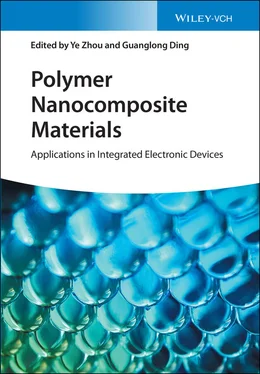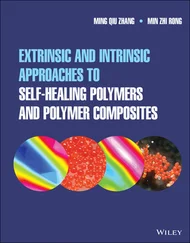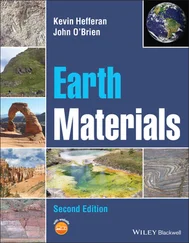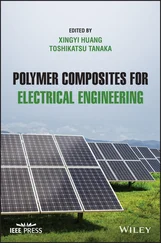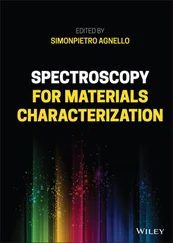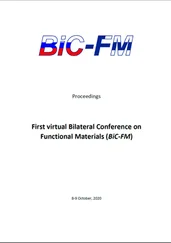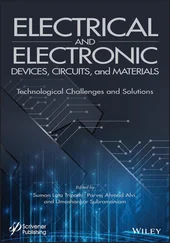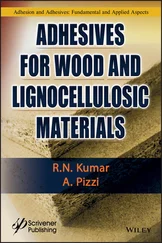Ball milling is widely used in metallurgy and mineral processing industry [96]. The principle of ball milling is to grind and mix powders in a closed space by using the huge shear force and compression force produced by hard ball collision. In the synthesis of PNCs, this method can disperse CNTs [97], graphene nanoparticles [98–101], silica nanoparticles [102], and BNs [103, 104] into thermoplastic and thermosetting polymers. The high shear force produced by ball milling can peel off some two-dimensional nanostructures, such as graphene, MoS 2, and BNs, but may not separate the interlayer structure connected by ionic bonding [105–110]. In addition, ball milling is not only suitable for solvent-free conditions but also solvent-free conditions, so nanofillers can be directly dispersed in some solid thermoplastic matrix, such as polyethylene (PE) [101, 111], polyphenylene sulfide [104, 112], and polymethyl methacrylate (PMMA) [102].
1.5.5 Double-screw Extrusion
Double-screw extrusion disperses nanofillers in thermoplastic matrix by huge shear force generated by high speed rotation of double-screw at high temperature [113, 114]. This method has been widely used in industry due to the advantages of solvent-free and environment-friendly technology. With this method, the fillers can be dispersed into the polymer in a high content way to achieve the well-controlled performance, and applied to different sizes of nanoparticles, such as graphene sheets [115], CNTs [116], and silicon dioxide [117]. This method needs higher temperature, which is helpful to reduce the viscosity of polymer and load more nanofillers, but also has the risk of decomposing polymers and nanofillers. The reason is owing to the existence of low thermal stability functional groups in the materials. When the temperature is too high, the fracture will occur, resulting in the deterioration of the performance of PNCs [118]. Moreover, the gap between the screws is too large to keep some aggregates of nanofillers evenly, which will not achieve the uniform monodispersing of nanofillers. So, it is necessary to combine other technologies to further improve the performance [119, 120].
In addition to the aforementioned methods of dispersing prepared nanofillers into polymers, another important synthesis strategy is in situ synthesis, which directly generates nanoparticles in polymers through molecular precursors [121]. This method can be divided into chemical and physical in situ synthesis [122]. Chemical in situ synthesis is used to synthesize nanoscale fillers by chemical reaction, such as the hydrothermal method and sol–gel method [123, 124]. The physical in situ synthesis is transforming the precursor of gas phase into inorganic nanoparticles through plasma action, and then condensing the organic compounds on the surface of inorganic particles to cover the polymer shell to form PNCs [125].
1.6 Conclusions and Future Outlook
In this chapter, the basic principles, properties, and synthesis methods of PNCs are clearly described. The composite material has unique structure and performance, and has a wide range of applications in many fields. The particle size, orientation, shape, dispersion, and volume dispersion of nanofillers affect the properties of PNCs. Most of the physical, chemical, and mechanical properties of PNCs depend on the interface interaction between the filler and the matrix. Therefore, the uniform dispersion of nanofillers is the most important consideration in the synthesis of PNCs. PNCs have recently become part of modern technology, but these areas are still in the early stage of development. With more and more scientists and engineers contributing to the understanding of PNCs, these functional materials will be applied in more and more fields.
1 1 Karak, N. (2019). Fundamentals of Nanomaterials and Polymer Nanocomposites. Elsevier.
2 2 Brunner, G. (2014). Supercritical Fluid Science and Technology, vol. 5 (ed. G. Brunner). Elsevier.
3 3 Pradhan, S., Lach, R., Le, H.H. et al. (2013). Effect of filler dimensionality on mechanical properties of nanofiller reinforced polyolefin elastomers. ISRN Polym. Sci. 2013: 1–9.
4 4 Jordan, J., Jacob, K.I., Tannenbaum, R. et al. (2005). Experimental trends in polymer nanocomposites-a review. Mater. Sci. Eng., A 393: 1–11.
5 5 Xiao, J. and Qi, L. (2011). Surfactant-assisted, shape-controlled synthesis of gold nanocrystals. Nanoscale 3: 1383–1396.
6 6 Koo, J. (2015). An Overview of Nanomaterials. Cambridge University Press.
7 7 Vigneshwaran, N., Ammayappan, L., and Huang, Q. (2011). Effect of Gum arabic on distribution behavior of nanocellulose fillers in starch film. Appl. Nanosci. 1: 137–142.
8 8 Hussain, F., Hojjati, M., Okamoto, M., and Gorga, R.E. (2006). Review article: polymer-matrix nanocomposites, processing, manufacturing, and application: an overview. J. Compos. Mater. 40: 1511–1575.
9 9 Theng, B.K.G. (1970). Interactions of clay minerals with organic polymers. some practical applications. Clays Clay Miner. 18: 357–362.
10 10 Usuki, A., Kawasumi, M., Kojima, Y. et al. (1993). Swelling behavior of montmorillonite cation exchanged for ω-amino acids by ∈-caprolactam. J. Mater. Res. 8: 1174–1178.
11 11 Kojima, Y., Usuki, A., Kawasumi, M. et al. (2011). Mechanical properties of nylon 6-clay hybrid. J. Mater. Res. 8: 1185–1189.
12 12 Ray, S.S. and Bousmina, M. (2007). Polymer Nanocomposites and Their Applications. American Scientific Publishers.
13 13 Winey, K.I. and Vaia, R.A. (2011). Polymer nanocomposites. MRS Bull. 32: 314–322.
14 14 Verdejo, R., Bernal, M.M., Romasanta, L.J. et al. (2018). Reactive nanocomposite foams. Cell. Polym. 30: 45–62.
15 15 Nieto, A., Lahiri, D., and Agarwal, A. (2012). Synthesis and properties of bulk graphene nanoplatelets consolidated by spark plasma sintering. Carbon 50: 4068–4077.
16 16 Schmidt, F.P., Ditlbacher, H., Hohenester, U. et al. (2012). Dark plasmonic breathing modes in silver nanodisks. Nano Lett. 12: 5780–5783.
17 17 Jung, S.-H., Oh, E., Lee, K.-H. et al. (2008). Sonochemical preparation of shape-selective ZnO nanostructures. Cryst. Growth Des. 8: 265–269.
18 18 Siril, P.F., Ramos, L., Beaunier, P. et al. (2009). Synthesis of ultrathin hexagonal palladium nanosheets. Chem. Mater. 21: 5170–5175.
19 19 Dong, X., Ji, X., Jing, J. et al. (2010). Synthesis of triangular silver nanoprisms by stepwise reduction of sodium borohydride and trisodium citrate. J. Phys. Chem. C 114: 2070–2074.
20 20 Nayak, B.B., Behera, D., and Mishra, B.K. (2010). Synthesis of silicon carbide dendrite by the arc plasma process and observation of nanorod bundles in the dendrite arm. J. Am. Ceram. Soc. 93: 3080–3083.
21 21 Vizireanu, S., Stoica, S.D., Luculescu, C. et al. (2010). Plasma techniques for nanostructured carbon materials synthesis. a case study: carbon nanowall growth by low pressure expanding RF plasma. Plasma Sources Sci. Technol. 19: 34016.
22 22 Mann, A.K.P. and Skrabalak, S.E. (2011). Synthesis of single-crystalline nanoplates by spray pyrolysis: a metathesis route to Bi2WO6. Chem. Mater. 23: 1017–1022.
23 23 Tiwari, J.N., Tiwari, R.N., and Kim, K.S. (2012). Zero-dimensional, one-dimensional, two-dimensional and three-dimensional nanostructured materials for advanced electrochemical energy devices. Prog. Mater Sci. 57: 724–803.
24 24 Kim, K.S., Zhao, Y., Jang, H. et al. (2009). Large-scale pattern growth of graphene films for stretchable transparent electrodes. Nature 457: 706–710.
25 25 Bae, S., Kim, H., Lee, Y. et al. (2010). Roll-to-roll production of 30-inch graphene films for transparent electrodes. Nat. Nanotechnol. 5: 574–578.
Читать дальше
